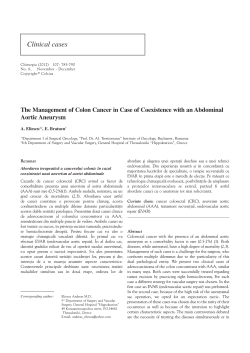
Topic: Stent-Graft for Repair of Abdominal Aortic Aneurysm
Topic: Stent-Graft for Repair of Abdominal Aortic Aneurysm Stent-grafts have emerged as a promising new catheter-based approach to the repair of abdominal aortic aneurysms (AAA). In this X-ray guided technique, the stent-graft is seated into the normal diameter aorta above and below the aneurysm, effectively isolating the aneurysm sac from the circulation. At the same time, the stent-graft provides a new, normal-sized lumen to maintain blood flow. The stentgraft is designed to fit tightly into the blood vessel, creating a pressure seal that prevents flow around the stent-graft into the aneurysm. Early experience suggests that in carefully selected patients stentgraft repair of AAA is safe and effective and has a lower morbidity than conventional surgery. The Advent of Stent-Graft Technology The idea of stent-grafts for treatment of aortic aneurysms was received with enthusiasm when the first trials in humans were reported by Parodi in 1991.1 In the intervening years, stent-grafts have become widely available, especially in Europe. There are a number of devices in clinical trials in the United States and two devices have FDA approval. The stent-graft device (Fig. 1) is an outgrowth of three existing technologies — metal stents, vascular graft materials, and catheters. When compressed and fitted onto a catheter, the stent-graft can be inserted through a small femoral arteriotomy, or possibly percutaneously. When released from the catheter, the stent-graft expands to a predetermined size and shape. Some devices have small barbs that help anchor the stent-graft in position. Results In approximately 70 percent to 80 percent of cases, the excluded aneurysm sac around the stentgraft thromboses completely within hours of the procedure.2 In the remaining 20 percent to 30 percent of patients, an endoleak may occur when a portion of the aneurysm sac remains incompletely thrombosed due to retrograde flow through lumbar arteries, the inferior mesenteric artery or the internal iliac artery. Approximately half of these aneurysms will thrombose completely after a few months.3 With thrombosis of the aneurysm, some shrinkage of the sac is usually observed over time. In some cases, the aneurysm disappears (see case history). Figure 1 A catheter is threaded through the abdominal aorta using X-ray guidance. The catheter is removed and the stent graft expands into place. Case History An 81-year-old female had a known infrarenal abdominal aortic aneurysm (AAA) that had grown from 4 cm to 5 cm in diameter in the past year. The patient’s condition was complicated by a history of remote myocardial infarction with stable angina and severe chronic obstructive lung disease. Aneurysm repair was warranted due to the rapid increase in diameter and the overall size of the aneurysm. The patient was considered to be at high risk for an anesthetic or postoperative complication and was referred to interventional radiology for evaluation to determine if she was a candidate for treatment with a stentgraft. Figure 3: Stent-graft procedure A. Digital subtraction angiogram obtained during the stent-graft procedure shows an infra-renal AAA. Figure 2 Infrarenal abdominal aortic aneurysm (AAA) in an 81- year-old woman. Axial CT scan shows a 5.0 cm diameter AAA (arrow). The patient underwent a helical contrastenhanced CT scan of the abdomen and conventional angiography using special graduated measuring catheters to help determine suitability for stent-graft repair. The imaging studies revealed that the aneurysm was isolated to the infrarenal aorta, with no involvement of the renal or iliac arteries (Fig 2). The aorta above and below the aneurysm appeared healthy and of normal caliber. After careful evaluation and measurements of all aspects of the aneurysm and the patient's iliac arteries, it was determined that the patient was a good candidate for stent-graft repair, and she was enrolled in an approved clinical trial. At the time B. Digital subtraction angiogram after deployment of the stent-graft shows exclusion of the aneurysm sac. that this patient was treated there were no commercially available stent-grafts in the United States. The patient was admitted the morning of her procedure. An epidural catheter was placed, but the patient remained awake for the procedure. A team consisting of a vascular interventional radiologist and a vascular surgeon performed the stentgraft repair. The right common femoral artery was exposed using a small incision, and the stent graft, mounted on a catheter, was placed through the femoral artery and into the infrarenal aorta under angiographic and fluoroscopic guidance (Fig. 3). Special care was taken to identify and localize the renal arteries and the aortic bifurcation. Delivery of the stent-graft was successful with complete exclusion of the aneurysm sac. After the procedure, the patient was monitored in the recovery room for several hours and transferred to a regular hospital Comparison with Open Surgical Repair bed. At the time of her discharge home on the third post-procedure day, the patient was ambulating well and tolerating a normal diet. A follow-up CT scan on the first day post-procedure showed thrombosis of the AAA. A scan at 6 months showed almost complete shrinkage of the aneurysm sac (Fig. 4). Figure 4: Serial CT scans obtained after placement of the stent-graft. Stent-graft repair of AAA differs from traditional surgical aneurysmectomy in several ways. A successful stent-graft procedure is highly dependent upon careful, detailed imaging for both treatment planning and execution. Selection of the correct stent-graft for a patient is based upon imaging studies, not direct observation of the aorta as in open repair. Similarly, deployment of the stentgraft in the proper location relies on correct interpretation of high quality intra-procedural imaging. The stent-graft is secured in the aorta primarily by pressing against the wall of the blood vessel. In surgery, the graft is secured with sutures. Following stent-graft repair, the AAA is thrombosed but still present. In contrast, the aneurysm is excised during surgical repair. Complications A. The day after placement of the stent-graft there is thrombosis of the AAA (arrow) with flow within the stent-graft. Figure 2: Infrarenal abdominal aortic aneurysm (AAA) in a 81-year-old woman. Axial CT scan shows a 5.0 cm diameter AAA (arrow). The morbidity of stent-graft procedures reported in the literature is significantly lower than that of conventional surgery, with fewer major complications, less need for recovery in intensive care units and lower overall blood loss. The average hospital stay is from two to three days (Table I).4,5 The long-term outcomes of stent-grafts for AAA are not yet known and delayed rupture of AAA following stent-graft repair has been reported in initial clinical trials.3 It is also important to note that not all patients are suitable candidates for stent-grafts, primarily due to anatomic features that cannot be accommodated by current stent-graft designs.6 Table I Comparison of procedural outcomes of stent-grafts versus open surgical repair. Parameter Open repair Stent-graft (n = 28) Blood loss (ml) B. Six months after placement of the stentgraft, the AAA has shrunk dramatically (arrow), so that only the stent-graft is visible. 1287 (n = 28) p Value 498 <0.01 Days in intensive care unit 1.75 0.1 0.008 Length hospital stay (days) 10.3 3.9 0.0001 Deaths 0 0 NS Total complications 20 20 NS Local complications 2 16 <0.001 Remote or systemic complications 18 4 <0.001 Recovery time (days) 47 11 0.0001 Represents the initial experience at the Massachusetts General Hospital. Adapted from reference 4. References: 1. Parodi JC, Palmaz JC, Barone HD. Transfemoral intraluminal graft implantation for abdominal aortic aneurysms. Ann Vasc Surg 1991;5:491-499. 2. Blum U, Voshage G, Lammer J,et al. Endoluminal stent-grafts for infrarenal abdominal aortic aneurysms. N Engl J Med 1997;336:13-20. 3. Matsumura JS, Moore WS. Clinical consequences of periprosthetic leak after endovascular repair of abdominal aortic aneurysm. J Vasc Surg 1998;27:606-613. 4. Brewster DC, Geller SC, Kaufman JA, et al. Initial experience with endovascular aneurysm repair: comparison of early results with outcome of conventional open repair. J Vasc Surg 1998;27:992-1005. 5. May J, White GH, Yu W, et al. Concurrent comparison of endoluminal versus open repair in the treatment of abdominal aortic aneurysms: analysis of 303 patients by lifetable method. J Vasc Surg 1998;27:213-221. 6. Duda SH, Raygrotzki S, Wiskirchen J, et al. Abdominal aortic aneurysms: treatment with juxtarenal placement of covered stent-grafts. Radiology 1998;206:195-198. Copyright © 2004 the Society of Interventional Radiology, www.SIRweb.org
© Copyright 2025



![[ PDF ] - journal of evolution of medical and dental sciences](http://cdn1.abcdocz.com/store/data/000670893_1-7a17ba26d33efa9aee8c022192eaa7f4-250x500.png)

















